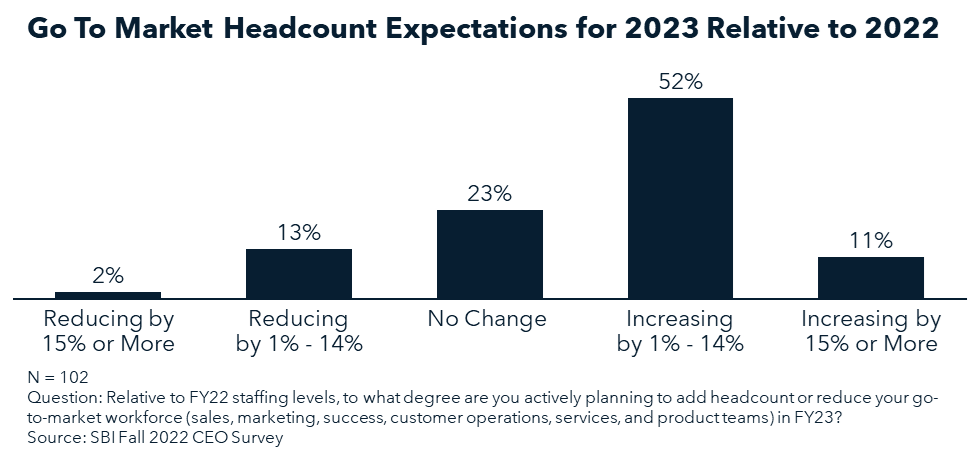Sales productivity is always a concern for CEOs and their go-to-market leadership teams. There's pressure mounting due to buyer uncertainty in a sideways market, a renewed focus on earnings versus growth, and owners and shareholders hungry for good news. Facing the background of a tight labor market, companies risk workforce burnout and missed opportunities to capture new markets.
Our recent survey of CEOs and go-to-market leaders reveals significant but addressable obstacles that must be contended with to drive sales productivity in 2023. Three key takeaways from the survey include:
- Plans to expand Sales headcount will be insufficient to adequately cover open territories
- Onboarding is insufficient to rapidly ramp new hires to productivity
- Identifying sources of employee burnout is necessary for sustained growth
Plans to expand Sales headcount will be insufficient to adequately cover open territories
Nearly half of the go-to-market leaders in our survey indicate that at least 15% of their territories are uncovered. Yet, most are planning to either add 10% or fewer new headcount or none at all in 2023. This means that, on a 1:1 basis, planned hiring will, in most cases, be insufficient to cover current business needs.

Leaders' hesitancy to hire is likely due to a tight labor market. They also fear new hires will not boost enough topline revenue to justify carrying their additional costs.
Two implications arrive from these concerns. Firstly, sales leaders must review and optimize territory design, or they run a significant risk of new hires being spread too thin. Secondly, sales productivity gains from the current team are required to sustain the status quo and further increase to realize growth.
How can sales leaders boost the team's productivity to achieve growth expectations?
- Refresh account segmentation and territory assignments to ensure adequate coverage while focusing on accounts with a high propensity to buy. This refresh needs to be part of a standard operating cadence. It can be augmented by adjusting rules of engagement to push targeted account-based marketing (ABM) motions, aligning customer-centric messaging and product offerings with customer needs.
- Arm the team with the necessary enablement to increase productivity and alleviate pressures. We recommend a comprehensive sales playbook that serves as the company standard for customer and prospect interactions. This makes them both more internally efficient and more efficient in their customer and prospect interactions.
- Strategic channel partner engagement helps maintain a presence in non-core markets that are hard to cover directly. In a time of uncertainty, leaders must rationalize the cost to play versus the benefit from competing in non-core markets. Channel engagement can extend reach with minimal headcount requirements and reduced risk.
Time to value is of the essence in down markets. Go-to-market leaders' ability to drive sales productivity will be vital in 2023. Market and stakeholder pressures require retention and enablement of employees to be effective more quickly and broadly than required historically. Organizations that proactively address their talent hurdles can emerge from an uncertain market with a stronger and highly productive sales force.
The complete report is available to SBI Growth Accelerator subscribers. Click here to learn more and access our latest research report.

